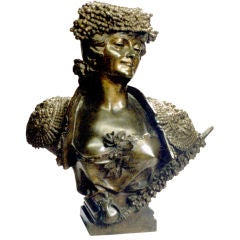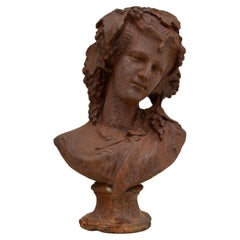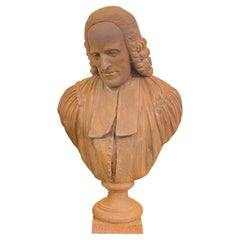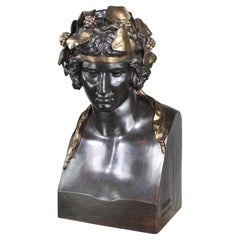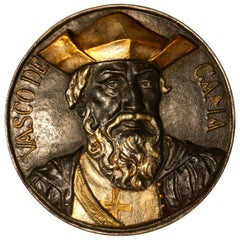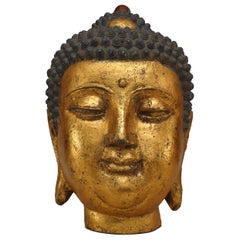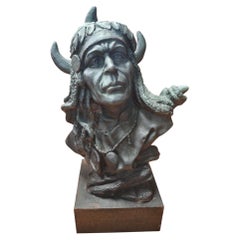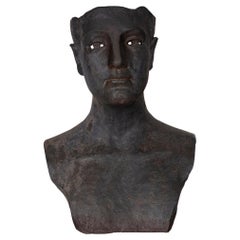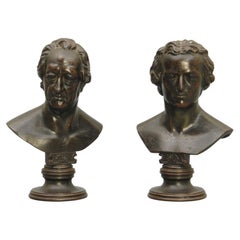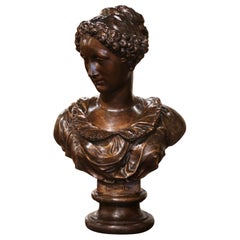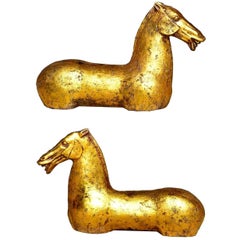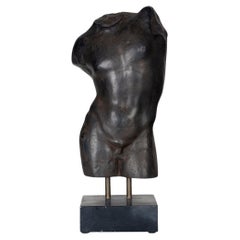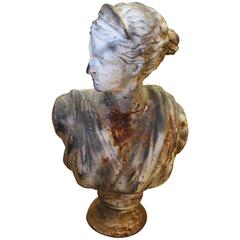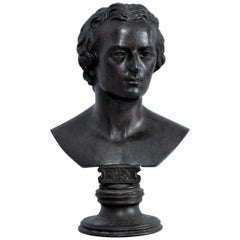Cast Iron Bust
Antique 19th Century Statues
Antique Early 1900s British Victorian Busts
Iron
Antique 18th Century French Statues
Iron
Antique 19th Century French Greco Roman Busts
Iron
Antique Late 19th Century Folk Art Wall-mounted Sculptures
Iron
20th Century Chinese Export Busts
Iron, Wrought Iron
Vintage 1950s Unknown Busts
Iron
Early 20th Century Organic Modern Busts
Iron
Antique Early 19th Century Austrian Busts
Iron
Antique Late 19th Century French Louis XVI Busts
Iron
20th Century Chinese Busts
Iron
20th Century Organic Modern Busts
Iron
Mid-20th Century Busts
Iron
Antique 1860s German Busts
Bronze
Antique 15th Century and Earlier Chinese Ming Busts
Iron
Antique 19th Century Tibetan Busts
Iron, Gold Leaf
Antique 19th Century British Early Victorian Busts
Brass, Bronze, Silver Plate
20th Century Busts
Bronze, Iron
Late 20th Century Unknown Victorian Figurative Sculptures
Iron
Mid-20th Century French Figurative Sculptures
Iron
Late 20th Century Unknown Victorian Figurative Sculptures
Iron
Vintage 1950s Japanese Mid-Century Modern Garden Ornaments
Bronze, Iron
2010s American Classical Greek Figurative Sculptures
Resin
Antique 1880s Greek Art Deco Animal Sculptures
Metal, Iron, Sheet Metal
Early 20th Century French Empire Revival Wall Lights and Sconces
Iron
Recent Sales
Antique 19th Century Unknown Busts
Antique 1860s German Romantic Busts
Metal
Antique 1880s Argentine Busts
Iron
Antique 19th Century Busts
Antique 19th Century French Romantic Busts
Iron
Antique 1820s French Empire Busts
Iron
Antique Mid-19th Century American Sculptures and Carvings
20th Century English Classical Roman Busts
Iron
21st Century and Contemporary Indonesian Modern Natural Specimens
Cast Stone
Antique Late 19th Century French Rococo Busts
Iron
Antique 19th Century American Statues
Iron
Antique 19th Century English Statues
Iron
Antique 19th Century French Sculptures
Antique 19th Century French Classical Greek Statues
Iron
20th Century Italian Neoclassical Statues
Iron
Antique 19th Century Spanish Busts
Iron
Antique Late 19th Century French Animal Sculptures
Iron
Antique 1880s French Busts
Metal, Iron
Late 20th Century American Modern Busts
Marble, Iron
Vintage 1960s British Busts
Iron
Vintage 1960s British Busts
Iron
20th Century French French Provincial Busts
Iron
Mid-20th Century Classical Greek Busts
Iron
Antique 19th Century French Busts
Iron
Early 20th Century Italian Neoclassical Busts
Carrara Marble, Iron
Antique 19th Century Italian Classical Roman Busts
Stone, Iron
Early 20th Century Mounted Objects
Marble, Iron
20th Century American American Colonial Animal Sculptures
Iron
20th Century French Animal Sculptures
Metal, Iron
Late 20th Century Animal Sculptures
Iron
Antique Early 1900s Statues
Other
Late 20th Century American Bookends
Iron
20th Century Classical Roman Statues
Iron
20th Century French Animal Sculptures
Iron
Vintage 1950s American Mid-Century Modern Bookends
Iron
Vintage 1930s American Federal Bookends
Iron
Antique 19th Century French Statues
Late 20th Century Unknown Expressionist Busts
Iron
21st Century and Contemporary Asian Modern Natural Specimens
Antique Early 19th Century American Empire Architectural Elements
Iron
Antique Early 19th Century Italian Neoclassical Busts
Iron
20th Century English Busts
Metal, Iron
20th Century Italian Busts
Marble, Iron
Antique Late 19th Century American Classical Wall-mounted Sculptures
Iron
Early 20th Century Cambodian Archaistic Metalwork
Iron, Gold Leaf
Antique 19th Century French Rustic Wall-mounted Sculptures
Iron
Late 20th Century Animal Sculptures
Iron
Antique 1860s French Napoleon III Fireplace Tools and Chimney Pots
Iron
20th Century Classical Roman Statues
Iron
Late 20th Century American Rustic Doors and Gates
Iron
Early 20th Century American American Classical Political and Patriotic M...
Iron
Mid-20th Century French Art Deco Floor Lamps
Brass, Bronze, Wrought Iron
Early 20th Century American Busts
Iron
Antique 1890s Argentine Busts
Iron
Antique 19th Century French Sculptures
20th Century Sculptures
Iron
Early 20th Century French Statues
People Also Browsed
Antique Late 19th Century Italian Classical Roman Pedestals and Columns
Marble
20th Century French Planters and Jardinieres
Cast Stone
21st Century and Contemporary English Georgian Pier Mirrors and Console ...
Gesso, Wood, Paint
21st Century and Contemporary British Hepplewhite Console Tables
Mahogany, Satinwood
Antique Late 19th Century Chinese Beds and Bed Frames
Lacquer, Wood
Antique 1860s British Victorian Beds and Bed Frames
Hardwood
Antique Late 19th Century French Romantic Busts
Marble, Bronze
20th Century Unknown Post-Modern Dining Room Tables
Stone, Travertine, Marble
Antique 19th Century European Chinoiserie Commodes and Chests of Drawers
Marble
2010s Brazilian Chairs
Cord, Wood, Hardwood
Antique Late 19th Century Natural Specimens
Coral
20th Century English Chesterfield Armchairs
Leather
Antique Mid-19th Century English High Victorian Taxidermy
Other
Antique Late 19th Century French Belle Époque Porcelain
Enamel, Bronze, Ormolu
Antique Late 19th Century Italian Renaissance Revival Busts
Marble, Belgian Black Marble, Carrara Marble
Antique Late 19th Century French Planters and Jardinieres
Iron
Cast Iron Bust For Sale on 1stDibs
How Much is a Cast Iron Bust?
- 1stDibs ExpertMay 3, 2024The difference between iron and cast iron comes down to content. Iron is generally pure iron, a chemical element that is a solid metal at room temperature. Cast iron is a mix of iron, carbon, silicon, manganese, sulfur, phosphorus and other elements. Both iron and cast iron can be used to produce furniture, cookware, decorative objects and other items. Generally, cast iron is heavier than iron. Shop an assortment of iron and cast iron pieces on 1stDibs.
- What are cast iron columns?1 Answer1stDibs ExpertMay 5, 2023Cast iron columns are vertical supports produced out of cast iron, a material made from iron and alloys with a carbon content of more than two percent. During the 19th century, cast iron columns were used in architecture. Today, they primarily function as decorative objects. Shop a range of cast iron columns on 1stDibs.
- Who invented cast iron?1 Answer1stDibs ExpertMay 3, 2024The name of the person who invented cast iron is unknown. However, anthropologists and archaeologists have determined that the ancient Chinese were the first to develop it. The earliest known examples of cast iron date back to the 6th century B.C. Cast iron production didn't begin in Europe until the 14th century A.D. Shop a collection of cast iron furniture and decorative objects on 1stDibs.
- Does cast-iron furniture rust?1 Answer1stDibs ExpertSeptember 25, 2019
Yes, cast-iron furniture rusts.
- 1stDibs ExpertMarch 31, 2023Cast iron is often used for benches because of its characteristics. Its strength makes it well-suited to support the weight of two or more adults, and its hardness allows it to resist damage due to weather exposure. Shop a range of cast iron benches on 1stDibs.
- 1stDibs ExpertApril 5, 2022Cast iron is frequently used for fireplaces due to its properties. The metal is highly durable, allowing it to hold up to the effects of frequent use. It also readily conducts heat to help warm up interiors. You'll find a variety of cast iron fireplaces on 1stDibs.
- When were cast iron beds made?1 Answer1stDibs ExpertFebruary 22, 2021Cast iron beds were made starting in the 1850s. These types of beds were handmade until World War I through the use of molds.
- Are cast iron columns hollow?1 Answer1stDibs ExpertMarch 31, 2023Whether cast iron columns are hollow depends on the piece. Most cast iron columns are hollow due to the manner of crafting, but some are solid. On 1stDibs, find a selection of columns.
- 1stDibs ExpertFebruary 17, 2023Yes, you can generally use cast iron as a planter because the material is durable and sturdy. However, you may need to drill drainage holes in a cast iron piece that wasn't intended to function as a planter to allow excess water to exit the vessel. On 1stDibs, find a selection of cast iron planters.
- 1stDibs ExpertMarch 22, 2022A cast iron fireplace insert is a firebox that fits into an existing fireplace surround. The insert is made of cast iron, a type of iron that is more than 2 percent carbon. Cast iron is highly durable and very resistant to the effects of heat. You'll find a selection of cast iron fireplace inserts on 1stDibs.
- 1stDibs ExpertAugust 17, 2021Cast iron trivets are used for many things but are especially ideal for slow cooking meat. They can prop up food in Dutch ovens to prevent burning and increase heat distribution.
- 1stDibs ExpertMarch 22, 2022Cast iron doorstops originated in the late 18th century. Osbourn Dursey invented the first doorstop in 1878. Decorative cast iron stops became popular in the 1920s and remained so throughout World War II. On 1stDibs, shop a variety of antique cast iron doorstops.
- 1stDibs ExpertSeptember 25, 2019
Cast iron is stronger than steel.
- 1stDibs ExpertSeptember 25, 2019
To keep a piece made of cast iron from rusting, place it in a cool, dry space with good air circulation.
- How do I hang a cast iron bell?1 Answer1stDibs ExpertMarch 22, 2022How to hang a cast iron bell depends on the style. Some cast iron bells have loops at the top that you can hang from a hook anchored onto your desired mounting surface. Others have brackets or frames that you can secure with mounting screws. On 1stDibs, shop a selection of cast iron bells.
- Do cast iron tables rust?1 Answer1stDibs ExpertMay 5, 2023Yes, cast iron tables can rust. Pieces are more likely to develop rust when exposed to humidity, such as in bathrooms or outdoor living spaces in coastal areas. Wiping surfaces clean regularly and touching up scratches and chips can reduce the risk of rust. On 1stDibs, shop a selection of cast iron tables.
- Do cast iron Firebacks work?1 Answer1stDibs ExpertAugust 24, 2021Yes, cast iron firebacks are quite sturdy and work really well. As they are made of solid iron, it's a challenge to move and place them. Given that, cast iron firebacks are the best protection for the back wall of the fireplace. Find a variety of firebacks on 1stDibs.
- 1stDibs ExpertSeptember 25, 2019
Unlike cast iron, wrought iron is not brittle and will bend rather than break. Wrought ironwork is produced with a hammer and anvil and tends to be more intricate than cast ironwork, which is characterized by repetitive designs that can be carved into a wooden pattern and cast.
- 1stDibs ExpertJune 30, 2023To tell if a cast iron doorstop is valuable, always look for original paint. Any that have been repainted or repaired will have diminished in value. You can also use online resources to try and research items, but the best way to find out if a cast iron doorstop is worth anything is to consult a certified appraiser. An experienced professional can evaluate the condition, determine the maker and research the piece to assign an approximate value. On 1stDibs, find a range of doorstops.
- 1stDibs ExpertApril 5, 2022Yes, cast iron umbrella stands and anything made of cast iron can rust. Keeping your cast iron umbrella stand away from moisture and humidity is the best way to keep it from rusting. However, because it is designed to hold wet umbrellas that may be impractical. Some people like to paint cast iron to protect it from rusting. You’ll find a variety of cast iron and other umbrella stands from some of the world’s top sellers on 1stDibs.
Read More
How a Craving for Color Revolutionized Glass
After synthetic dyes changed fashion, home goods and printed matter, it was only a matter of time till glass caught up.
Kazuyo Sejima’s Flowering Tree Blooms Year-Round
The brilliantly simple design turns a modest bouquet into a major statement.
He Wrote ‘Oedipus Rex,’ but Do You Know What He Looked Like?
The Greek tragedian is said to have been handsome in his day.
Cigar Culture Was Once the Peak of Masculinity. Now, It’s a Compelling Curiosity
Even for those who don’t indulge, elegant smoking accessories and audacious art portraying cigar enthusiasts hold a nostalgic allure.
African Travel Plans on Hold? This Ardmore Leopard Vase Brings the Beauty of the Savanna to You
It’s an excellent example of the sought-after ceramics coming out of South Africa’s KwaZulu-Natal province.
With a High-Tech Flagship and Cool Collabs, Lladró Is Breaking the Mold for Porcelain Production
Thanks to its new leadership, the Spanish maker of figurines, busts and lighting is on a mission to update the art of porcelain for the 21st century.
Zoë Powell’s Magnolia 05 Vessel Is Handmade from Clay She Unearthed Herself
The free-form stoneware piece is inspired by the magnolia tree and its associations with home.
8 Ways to Breathe New Life into a Space with Plants
The pair behind the Instagram account @houseplantclub share their tips for making any room of the house gloriously green.
